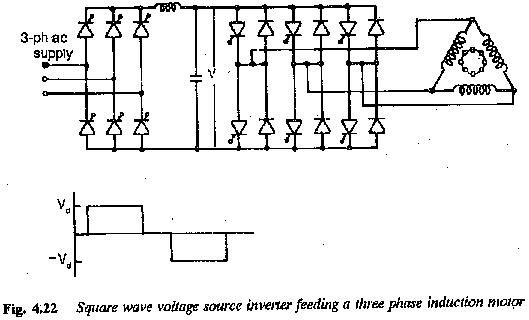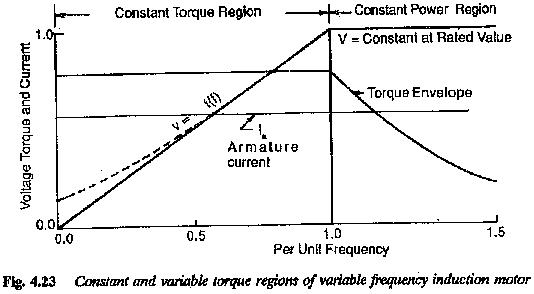Square Wave Voltage Source Inverter Fed Induction Motor Drive:
Square Wave Voltage Source Inverter Fed Induction Motor Drive is a kind of dc link converter, which is a two stage conversion device. A three phase supply is first rectified using a rectifier on the line side. The rectified dc is inverted to ac of desired frequency by an inverter on the load side, as shown in Fig. 4.22. When the load cannot provide the required reactive power for the inverter, the inverter has to necessarily be a force commutated one. The inductance in the dc link circuit provides smoothing whereas the capacitance maintains the constancy of link voltage. The link voltage is a controlled quality. The instantaneous voltage at the machine terminals (at the output terminals of the inverter) is at all times directly proportional to the dc link voltage (dc supply which is of low internal impedance) and the machine current (output) is a function of load admittance. Therefore, the ideal load for a Square Wave Voltage Source Inverter Fed Induction Motor, in view of harmonics in load current, should be highly inductive and have a low powerfactor.
By proper switching of the inverter thyristors the dc link voltage is impressed across the phases of the induction motor alternately. The voltage waveform at the output terminals depends purely on this switching and conduction of thyristors. If the thyristors conduct 180° in a period, the output voltage is in the form of a square wave. In this case the voltage control is obtained by means of a phase controlled rectifier on the line side. The dc link voltage is variable and the output voltage waveform remains the same at all loads and frequencies. The inverter is also called a square wave inverter, as the output voltage is a square wave.
These inverters have commutation problems at very low frequencies, as the dc link voltage available at these frequencies cannot charge the commutating capacitors sufficiently enough to commutate the thyristors. This puts a limit on the lower frequency of operation. To extend the frequency towards zero, special charging circuits must be used. The speed control range of the Square Wave Voltage Source Inverter Fed Induction Motor operating on a square wave inverter is 1 : 20.
The polarity of the dc link voltage cannot be changed. Hence during regeneration the current direction in the link circuit must be reversed. A separate phase controlled converter is required on the line side for regeneration, as shown in Fig. 4.22. Dynamic braking can be employed by means of resistors switched. The dynamic behaviour of the system is not very good at low frequencies.
Soft starting of the motor is possible. A machine operating on a variable frequency, variable voltage converter does not require additional starting equipment. The machine normally operates on the linear portion of the torque-speed curve and does not see locked rotor torque and current in its starting. The machine has identical characteristics from the synchronous point to the maximum torque point, at every frequency. The machine torque and current can be kept constant in this range by varying the frequency and voltage simultaneously and smoothly at constant torque and current to the required speed, by varying the stator frequency and keeping the rotor frequency constant. The acceleration is at constant flux slip controlled mode. The mode in which the slip is kept constant and flux is controlled (constant slip flux controlled mode) is also possible for starting purposes. These methods add to the efficiency of the drive.
When the slip is used as a controlled quantity to maintain the flux constant in the motor the drive is called slip controlled drive. By making the slip negative (i.e., decreasing the output frequency of the inverter) the machine may be made to operate as a generator and the energy of the rotating parts fed back to the mains by an additional line side converter or dissipated in a resistance for dynamic braking. By keeping the slip frequency constant (or controlling slip), braking at constant torque and current can be achieved. Thus, braking is also fast.
Since the voltage can be varied to maintain the constant flux, constant torque operation is possible up to rated frequency. Beyond the rated frequency, the voltage remains at its rated value and the machine operates in flux weakening mode. The motor gives constant output at all speeds and is called constant horse power mode. These modes are depicted in Fig. 4.23.
The motor receives square wave voltages. This voltage has harmonic components. The resulting armature current is non-sinusoidal, having peaks. These peaks actually decide the design rating of the inverter. The harmonics of the stator current cause additional losses and heating. The motor therefore requires a derating, or for a given horse power an overdimensioned motor must be used.
These harmonics are also responsible for torque pulsations. The reaction of the fifth and seventh harmonics with the fundamental gives rise to the sixth harmonics the torque developed. For a given Square Wave Voltage Source Inverter Fed Induction Motor fed from a square wave inverter the harmonic content in the current tends to remain constant independent of input frequency, within the range of operating frequencies of the inverter.
The peak and harmonic currents of the line as well as stator current are influenced by the leakage reactance of the motor. Higher the leakage reactance smaller is the harmonic content and the peak value of the stator current. It is therefore necessary to choose an induction motor having a large leakage reactance for operation on a Square Wave Voltage Source Inverter Fed Induction Motor. As the peak currents are less, the design rating of the inverter decreases. Open loop control is possible, but may have stability problems at low speeds.
Multimotor operation is possible and commutation is load independent. The converter represents a source and the motor can be just plugged on. Therefore, no matching between converter and load is necessary.
As slip controlled drive, a VSI fed motor has the following additional features:
An indirect flux control can be achieved by slip control. As the steady state quantities are specified in the control, the dynamic behaviour may not be satisfactory. Precise control of torque over a wide range of speeds is possible (sometimes down to standstill). It is a very efficient drive, having a very good efficiency and power factor, when the slip frequency is limited to the linear portion of the torque-speed curve.
No starting equipment is required and very fast acceleration is possible at constant torque and current. Regeneration or dynamic braking is also possible at constant torque and current. Four quadrant drive is possible. Closed loop control of frequency provides a variable speed drive having characteristics of dc motor in Ward Leonard system.
The features of an Square Wave Voltage Source Inverter Fed Induction Motor can be summarized as follows:
1.The inverter has impressed dc voltage of variable amplitude.
2.Advantageous for multimotor drive.
3.Commutation is load independent. Converter and load need not be The converter represents a source to which the motor can be just plugged on.
4.At present converter output frequencies up to 1500 Hz are possible. This drive is very much suitable for (motors of) high speed operation. The drives are available up to rating of 200 KVA.
5.The lowest operating frequency as limited by commutation is about 5 Hz. Speed range is 1 : 20.
6.Not suitable for, acceleration on load and sudden load changes.
7.Dynamic behaviour is fairly good at high speeds.
8.Dynamic braking is possible. Regeneration (Four quadrant operation) requires an additional converter connected- antiparallel to the line side one. Speed reversal is obtained by changing the phase sequence.
9.The input voltage to the motor is nonsinusoidal. This results in additional losses, heating and torque pulsations.
10.Motor should have sufficiently large leakage inductance to limit the peak currents and decrease thp harmonic content.
11.Open loop control of the motor is possible, but may have ‘stability problem at low speeds.
12.Line power factor is poor due to phase control.
13.It can be operated as a slip controlled drive.
14.It finds application as a general purpose industrial drive for low to medium power.

